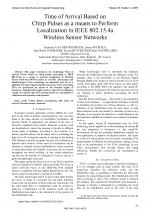| 2/2010 - 11 |
| Extra paper information in |
| Click to see author's profile in |
| Download PDF |
Author keywords
Chirp Pulses, localization, RF, Time Of Arrival, Wireless Sensor Networks
References keywords
location(5), estimation(4)
No common words between the references section and the paper title.
About this article
Date of Publication: 2010-05-31
Volume 10, Issue 2, Year 2010, On page(s): 65 - 70
ISSN: 1582-7445, e-ISSN: 1844-7600
Digital Object Identifier: 10.4316/AECE.2010.02011
Web of Science Accession Number: 000280312600011
SCOPUS ID: 77954634861
Abstract
This paper introduces the technology Time of Arrival (TOA) based on chirp pulses (according to IEEE 802.15.4a) as a means to perform localization in Wireless Sensor Networks (WSN's) active at 2.4 GHz. Advantages and disadvantages of the technology are discussed and act as a guideline for improving localization accuracy. Tests concerning TOA are performed by means of the location engine of Nanotron. Adapting this engine leads to improved localization results. It is shown that TOA measurements are susceptible to reflections and dynamic environments. |
| References | | | Cited By «-- Click to see who has cited this paper |
| [1] N. Patwari, "Location estimation in sensor networks", pp. 22-34, 2005.
[2] ***, Real Time Location Systems (RTLS) - White paper, version 1.02, NA-06-0148-0391-1.02, Nanotron. [3] nanoLOC Development Kit - User Guide, version 1.03, NA-06-0230-0402-1.03, Nanotron. [4] Y. Jiang and V. Leung, "An Asymmetric Double Sided Two-Way Ranging for Crystal Offset", IEEE 1-4244-1449-0/07, pp. 525-528, 2007. [5] J. Lampe, R. Hach, L. Menzer, K.-K. Lee and J.-W. Chong, "DBOCSS PHY Presentation for 802.15.4a, "IEEE 15-05-0126-01-004a, 2005. [6] A.T. Ali, H. Sayed and N. Khajehnouri, "Network-based wireless location," pp. 27-28, 2005. [7] N. Patwari, "Location estimation in sensor networks", A dissertation submitted in partial fulfilment of the requirements for the degree of Doctor of Philosophy (Electrical Engineering: Systems), University of Michigan, 2005. [8] Van Nieuwenhuyse A., Ottoy G., Goemaere J.-P., De Strycker L., "Indoor Localisation Techniques: Comparison between the Use of RSS and TOA, "Proceedings of the Third European Conference on the Use of Modern Information and Communication Technologies, ISBN 9-78908082-553-6, 2008. [9] A. Hein, "Processing of SAR DATA- Fundamentals, Signal Processing, Interferometry," ISBN 3-540-05043-4, pp.23-44, 2004. [10] ***, nanoNET Chirp Based Wireless Networks - White paper, version 1.04, NA-04-0000-0298-1.04, Nanotron. [11] ***, "The Kolmogorov-Smirnov test", Available: Temporary on-line reference link removed - see the PDF document [12] S. Chandran, "Advances in Direction-of-Arrival Estimation," ISBN 1-59693-004-7, 2006. [13] ZigBee Alliance, ZigBee Specification, ZigBee Document 053474r17, January 2008. [14] K. D'hoe, G. Ottoy, J.-P. Goemaere, L. De Strycker, "Indoor Room Location Estimation", Advances in Electrical and Computer Engineering, Vol. 8, No. 2, pp. 78-81, 2008. [CrossRef] [Full Text] [Web of Science Times Cited 10] [SCOPUS Times Cited 13] Web of Science® Citations for all references: 10 TCR SCOPUS® Citations for all references: 13 TCR Web of Science® Average Citations per reference: 1 ACR SCOPUS® Average Citations per reference: 1 ACR TCR = Total Citations for References / ACR = Average Citations per Reference We introduced in 2010 - for the first time in scientific publishing, the term "References Weight", as a quantitative indication of the quality ... Read more Citations for references updated on 2025-05-29 10:50 in 9 seconds. Note1: Web of Science® is a registered trademark of Clarivate Analytics. Note2: SCOPUS® is a registered trademark of Elsevier B.V. Disclaimer: All queries to the respective databases were made by using the DOI record of every reference (where available). Due to technical problems beyond our control, the information is not always accurate. Please use the CrossRef link to visit the respective publisher site. |
Faculty of Electrical Engineering and Computer Science
Stefan cel Mare University of Suceava, Romania
All rights reserved: Advances in Electrical and Computer Engineering is a registered trademark of the Stefan cel Mare University of Suceava. No part of this publication may be reproduced, stored in a retrieval system, photocopied, recorded or archived, without the written permission from the Editor. When authors submit their papers for publication, they agree that the copyright for their article be transferred to the Faculty of Electrical Engineering and Computer Science, Stefan cel Mare University of Suceava, Romania, if and only if the articles are accepted for publication. The copyright covers the exclusive rights to reproduce and distribute the article, including reprints and translations.
Permission for other use: The copyright owner's consent does not extend to copying for general distribution, for promotion, for creating new works, or for resale. Specific written permission must be obtained from the Editor for such copying. Direct linking to files hosted on this website is strictly prohibited.
Disclaimer: Whilst every effort is made by the publishers and editorial board to see that no inaccurate or misleading data, opinions or statements appear in this journal, they wish to make it clear that all information and opinions formulated in the articles, as well as linguistic accuracy, are the sole responsibility of the author.



